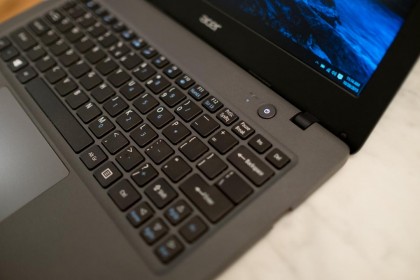TechRadar Verdict
Small, light, and inexpensive, the Acer Aspire Cloudbook has all the basic features to get by … but not much more than that.
Pros
- +
Very inexpensive
- +
Comes with Office 365 subscription
- +
Exterior has nice feel
Cons
- -
Bad viewing angles
- -
Weak speakers
- -
Doesn't stand out against competition
Why you can trust TechRadar
With the immense success of applications like Office 365 and tools like OneDrive, Microsoft has done well to stay in the cloud. That's also where ultra portable laptops like the Acer Aspire One Cloudbook 11 comes from. Available in two screen sizes, 11.6 and 14-inch, the Acer Cloudbook is a low-cost, lightweight, system that takes full advantage of Windows 10.
Given how every configuration is equipped with an 1.6GHz Intel Celeron dual-core processor and 2GB of memory, the Cloudbook isn't built for power. Nor is it convertible to a tablet, the way the Asus Transformer Book Flip TP200SA or HP Pavilion x2 are, despite having similar specifications.
Instead, it's a compact laptop that practically requires you to use online applications because it only has 32GB of storage on tap. It even comes with a 1-year subscription to Office 365 and 1 TB of OneDrive cloud storage packed in to persuade you into a cloud-based lifestyle.
Now that it has been out for a few years, there's some brilliant deals out there for the Acer Aspire One Cloudbook 11, now is a good time to bag yourself a bargain for this useful device.

Design
Minimal by design, the Cloudbook has two USB ports (only one is USB 3.0), an HDMI port, and a headphone jack. Its exterior has a dimpled texture (similar to a golf ball) that covers the screen lid, which gives the system a nice tactile feel when carrying it around.
Meanwhile, the matte screen is good for using the computer in sunlight, but the picture starts washing out when it's tilted too far forward or back. Combined with the unsurprisingly weak downward firing speakers, with a volume that changes depending on surface the laptop is sitting on, the Cloudbook isn't a greatest option for watching streaming video.

The small laptop also has very small keys, and F-keys in particular feel microscopic. I wouldn't rely on the Cloudbook for long computing sessions, but found that it works best for writing quick emails, browsing the web and writing short documents before tucking it away again. Its relatively large touchpad recognizes gestures like pinch and zoom, which sort of helps make up for the fact that it doesn't have a touchscreen, but not by much.
Sign up for breaking news, reviews, opinion, top tech deals, and more.
Then there's the matter of its low-resolution webcam, making it less than ideal for video conferencing. Generally speaking, if you're looking for a no-frills, low-cost, notebook that relies on the cloud to do almost all the heavy lifting for apps, then this is it.

No cloud required
Despite its heavy reliance on the cloud (as its name indicates), there's no practical difference between using a Cloudbook or any other Windows 10 laptop. There's a full desktop environment, the digital assistant Cortana and Microsoft Edge. You're encouraged to stay within the Microsoft ecosystem for productivity and entertainment, but you're not limited to first party apps.
Unlike Chromebooks, which requires you to use Chrome OS, the Chrome browser and its apps, you have the full power and versatility of Windows 10. That means you're not necessarily limited to using Groove Music and web players to stream music. You could install iTunes or the Amazon music player, if that's where you keep your music. And you can switch to a different browser if you're unsatisfied with Microsoft Edge.
If you're already accustomed to using cloud applications, then there won't be any noticeable shift in the Windows experience. The only difference between a Cloudbook and any other Windows 10 PC is relatively low-end hardware and that it doesn't have a lot of memory or storage space. Although, you might not want to install too many apps locally: it's good to have more options and flexibility.
